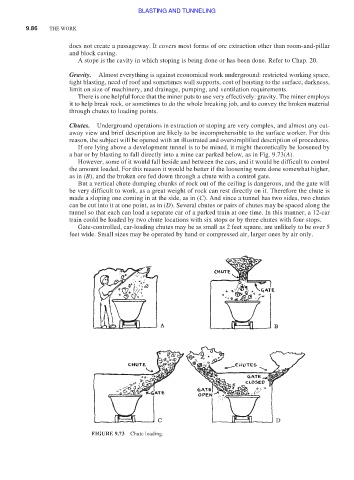Page 486 - Moving the Earth_ The Workbook of Excavation
P. 486
BLASTING AND TUNNELING
9.86 THE WORK
does not create a passageway. It covers most forms of ore extraction other than room-and-pillar
and block caving.
A stope is the cavity in which stoping is being done or has been done. Refer to Chap. 20.
Gravity. Almost everything is against economical work underground: restricted working space,
tight blasting, need of roof and sometimes wall supports, cost of hoisting to the surface, darkness,
limit on size of machinery, and drainage, pumping, and ventilation requirements.
There is one helpful force that the miner puts to use very effectively: gravity. The miner employs
it to help break rock, or sometimes to do the whole breaking job, and to convey the broken material
through chutes to loading points.
Chutes. Underground operations in extraction or stoping are very complex, and almost any cut-
away view and brief description are likely to be incomprehensible to the surface worker. For this
reason, the subject will be opened with an illustrated and oversimplified description of procedures.
If ore lying above a development tunnel is to be mined, it might theoretically be loosened by
a bar or by blasting to fall directly into a mine car parked below, as in Fig. 9.73(A).
However, some of it would fall beside and between the cars, and it would be difficult to control
the amount loaded. For this reason it would be better if the loosening were done somewhat higher,
as in (B), and the broken ore fed down through a chute with a control gate.
But a vertical chute dumping chunks of rock out of the ceiling is dangerous, and the gate will
be very difficult to work, as a great weight of rock can rest directly on it. Therefore the chute is
made a sloping one coming in at the side, as in (C). And since a tunnel has two sides, two chutes
can be cut into it at one point, as in (D). Several chutes or pairs of chutes may be spaced along the
tunnel so that each can load a separate car of a parked train at one time. In this manner, a 12-car
train could be loaded by two chute locations with six stops or by three chutes with four stops.
Gate-controlled, car-loading chutes may be as small as 2 feet square, are unlikely to be over 5
feet wide. Small sizes may be operated by hand or compressed air, larger ones by air only.
FIGURE 9.73 Chute loading.

